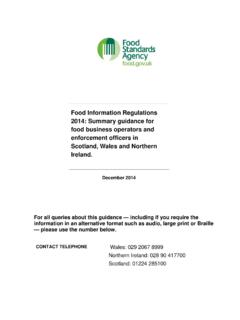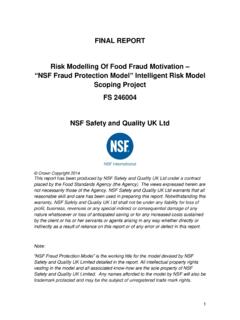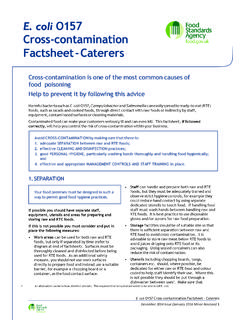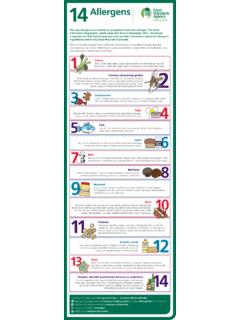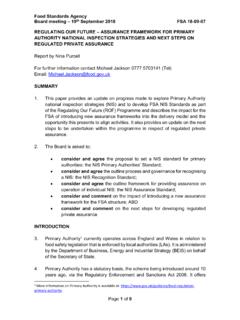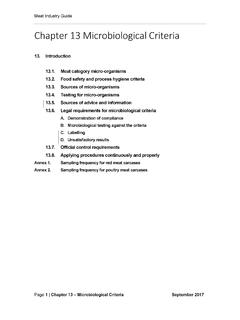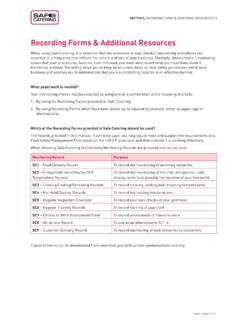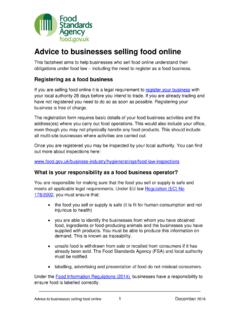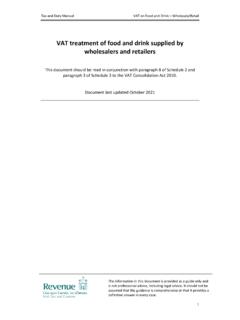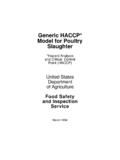Transcription of If you require this information in an alternative format ...
1 If you require this information in an alternative format such as audio, large print, Braille please contact us. CRITERIA FOR THE USE OF THE TERMS fresh , PURE, NATURAL ETC. IN FOOD LABELLING The Agency s aims in providing these criteria for the use of marketing terms are to: assist manufacturers, producers, retailers and caterers decide when these descriptions may be used and when they should not; help enforcement authorities to provide consistent advice about labelling; and benefit consumers, by encouraging the adoption of consistent, transparent labelling practices. Revised July 2008 CRITERIA FOR THE USE OF THE TERMS fresh , PURE, NATURAL ETC IN FOOD LABELLING CONTENTS Paragraphs INTENTED AUDIENCE 1 LEGAL STATUS 2 - 3 PURPOSE 4 8 BACKGROUND TO THE CREATION OF THE guidance 9 - 13 _____ PART 1 RELEVANT LEGISLATION 14 - 15 _____ PART 2 GENERAL BEST PRACTICE ADVICE 16 - 25 _____ PART 3 SPECIFIC BEST PRACTICE ADVICE fresh 26 - 50 Natural 51 - 62 Pure 63.
2 67 Traditional 68 - 71 Original 72 - 75 Authentic , Real and Genuine 76 - 80 Home made 81 - 84 Farmhouse 85 - 91 Farmhouse P t 92 Hand-made 93 Premium , Finest , Quality and Best 94 _____ CONTACT DETAILS 95 ANNEX 1: Lacors circulars Page 29 ANNEX 2: The EU Protected Food Name Scheme Page 31 Revised July 2008 2 INTENDED AUDIENCE 1.
3 The Agency s aims in providing these criteria for the use of marketing terms are to: Assist manufacturers, producers, retailers and caterers decide when these descriptions may be used and when they should not. Help enforcement authorities to provide consistent advice about labelling and to challenge inappropriate uses of marketing terms. However, it is acknowledged that there is no legal obligation to follow the recommended criteria. Whether this advice is followed or not, misleading labelling is an offence under legislation. LEGAL STATUS 2. This guidance has been produced to provide informal, non-binding advice on: the relevant legal requirements for labelling food with marketing terms (Part 1); and general (Part 2) and specific (Part 3) best practice on the use of marketing terms. 3. The advice offered in this guidance should not be taken as an authoritative statement nor an interpretation of the law, as only the courts have this power.
4 It is ultimately the responsibility of individual businesses to ensure their compliance with the law. Compliance with the advice on best practice is not required by law. PURPOSE 4. The Food Standards Agency is committed to promoting informed consumer choice. The Agency wishes to promote best practice regarding the provision of information to consumers and help consumers to make more informed food choices. 5. This guidance sets out voluntary best practice advice on the use of marketing information , particularly commonly used marketing terms that are of interest to consumers but not defined in law. It is issued to encourage the use of labelling terms that convey clear meaning and are not misleading. The use of these terms should be considered in the context of the label as a whole, the presentation of the product and on a case by case basis.
5 6. The best practice advice applies equally to all food, regardless of whether it is prepacked or not, or the type of outlet from which it is sold. Revised July 2008 37. The Agency s advice on use of these terms is in line with current consumer understanding and is intended to encourage a common approach for industry which is consistent with current market practices. 8. Businesses with specific queries should seek the advice of their local enforcement agency, which will usually be the Trading Standards department of the local authority. BACKGROUND TO THE CREATION OF THE guidance 9. In 2001, consumer research, public consultations and correspondence demonstrated that consumers were concerned about the way some descriptions on labels had become unclear in their meaning. The Agency therefore invited the Food Advisory Committee (FAC) to investigate the use of a number of terms and advise how misuse might be avoided.
6 These terms were: fresh Original Natural Authentic Pure Home-made Traditional Farmhouse 10. The FAC concluded2 that the basic legislative requirements were sufficient in principle to ensure that consumers are not misled in this area of claims. However, the FAC also found that these terms were being misused in some cases, and that there was clear room for improvement. It felt that terms were being used to convey messages that had in some cases become far-removed from their generally accepted meanings and had the potential to mislead consumers, even after making due allowance for changes to the accepted meaning and use of words over time. The Committee made a number of recommendations, which were taken as the basis for the first issue of the guidance in 2002.
7 11. In 2004 the Agency carried out a survey, An investigation of the use of the terms such as natural, fresh etc. in food labelling that looked at the extent to which industry was taking account of the guidance , and to help inform whether it should be revised. Of the 220 samples examined, 88 (40%) were considered by the participating public analysts not to follow the guidance . 12. The 2002 guidance was discussed at an Agency stakeholder meeting in 2005 and it was recognised that: 2 FAC Review of the use of the terms fresh , Pure, Natural etc in Food Labelling 2001 FSA/0334/0701. Revised July 2008 4 advice for some of the terms might not be in line with currently understood meanings; and new terms had come into use that were not in the guidance and that these may be being used in potentially misleading ways.
8 13. As a result it was decided to commission further consumer research. A report of the research was published on the Agency website in 20063. The revised guidance takes account of the findings of this research. All of the existing terms have been revised except for homemade and are set out in the table below with the new terms that are now covered in the guidance : Revised existing termsNew terms Original Farmhouse (P t ) Homemade Hand-made Traditional Selected# Authentic Quality # Real Premium # fresh * Finest # Pure* Best # Natural* Seasonal# Farmhouse* Style# Wild# Type# *The advice on these terms was not identified as requiring any consumer research but they have been revised in the light of recent enquiries and issues that have arisen from
9 Consumers, enforcement authorities and industry prior to and during the consultation. #General advice only is provided on these terms. This term has not been revised, although the consultation had suggested an amendment. 3 WEBLINK: Revised July 2008 5 PART 1 RELEVANT LEGISLATION 14. The advice in this guidance relates to, and should be read in conjunction with the provisions of several pieces of legislation that are intended to protect consumers from false or misleading labelling as set out below: Article 16 of Regulation (EC) No 178/2002 (on the general principles and requirements of food law) requires that the labelling, advertising and presentation of food, and the information made available about it through whatever medium, should not mislead consumers Article 2 of Directive 2000/13/EC (on food labelling) requires that the labelling, advertising and presentation of a food must not be such as could mislead a purchaser to a material degree, particularly - as to the characteristics of the food and, in particular, as to its nature, identity, properties, composition, quantity, durability, origin or provenance, method of manufacture or production; - by attributing to the food effects or properties that it does not possess.
10 - by suggesting the food possesses special characteristics when in fact all similar foods possess such characteristics the Food Safety Act 1990 prohibits the sale of any food that is not of the nature, substance or quality demanded by the purchaser; and makes it an offence to describe, present or advertise food in a way that is false or likely to mislead the consumer the Consumer Protection from Unfair Trading Regulations 2008 prohibits unfair commercial practices that include misleading actions which could be false information or overall presentation that deceives the average consumer such that the average consumer would make a transactional decision that they would not have taken otherwise (it may be helpful to become familiar with the detail of this Statutory Instrument No. 2008/1277) the general provisions of the Food Labelling Regulations 1996 Revised July 2008 6including the provisions on the name of the food at Regulations 6, 7, 8, 9, 10 and 11 which cover the use of a name that must indicate the true nature of the food when there is no name prescribed by law or customary name, the use of trade marks, brand names and fancy names and also the indication of physical condition or treatment.
